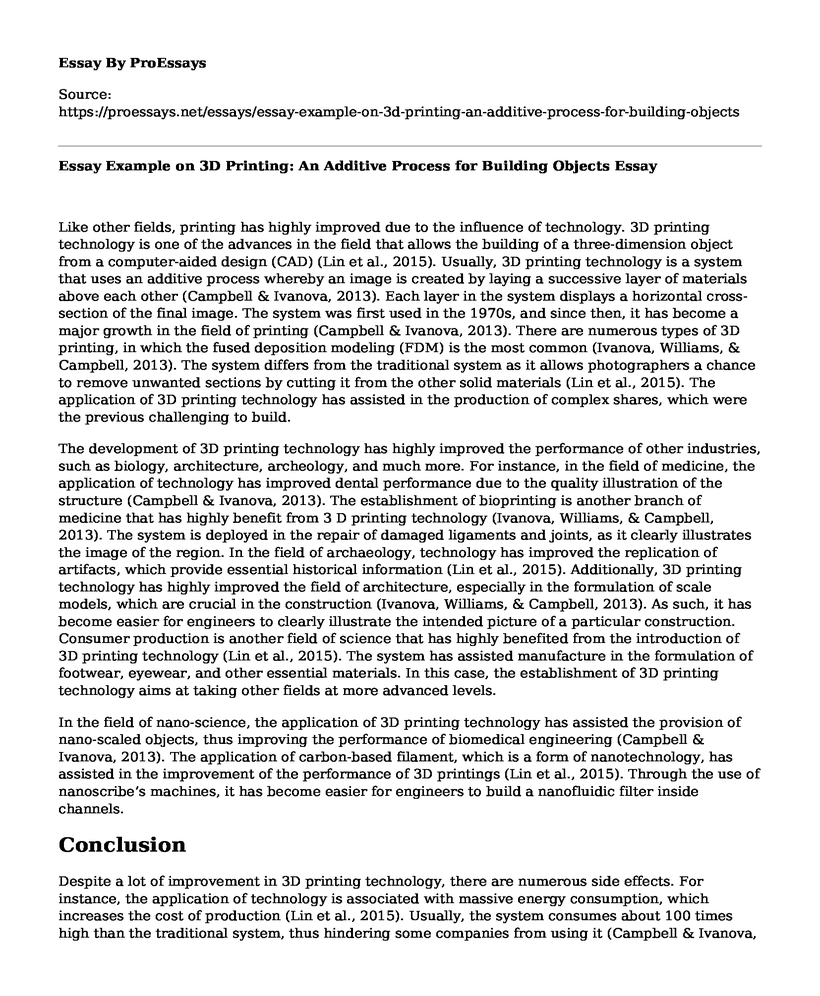Like other fields, printing has highly improved due to the influence of technology. 3D printing technology is one of the advances in the field that allows the building of a three-dimension object from a computer-aided design (CAD) (Lin et al., 2015). Usually, 3D printing technology is a system that uses an additive process whereby an image is created by laying a successive layer of materials above each other (Campbell & Ivanova, 2013). Each layer in the system displays a horizontal cross-section of the final image. The system was first used in the 1970s, and since then, it has become a major growth in the field of printing (Campbell & Ivanova, 2013). There are numerous types of 3D printing, in which the fused deposition modeling (FDM) is the most common (Ivanova, Williams, & Campbell, 2013). The system differs from the traditional system as it allows photographers a chance to remove unwanted sections by cutting it from the other solid materials (Lin et al., 2015). The application of 3D printing technology has assisted in the production of complex shares, which were the previous challenging to build.
The development of 3D printing technology has highly improved the performance of other industries, such as biology, architecture, archeology, and much more. For instance, in the field of medicine, the application of technology has improved dental performance due to the quality illustration of the structure (Campbell & Ivanova, 2013). The establishment of bioprinting is another branch of medicine that has highly benefit from 3 D printing technology (Ivanova, Williams, & Campbell, 2013). The system is deployed in the repair of damaged ligaments and joints, as it clearly illustrates the image of the region. In the field of archaeology, technology has improved the replication of artifacts, which provide essential historical information (Lin et al., 2015). Additionally, 3D printing technology has highly improved the field of architecture, especially in the formulation of scale models, which are crucial in the construction (Ivanova, Williams, & Campbell, 2013). As such, it has become easier for engineers to clearly illustrate the intended picture of a particular construction. Consumer production is another field of science that has highly benefited from the introduction of 3D printing technology (Lin et al., 2015). The system has assisted manufacture in the formulation of footwear, eyewear, and other essential materials. In this case, the establishment of 3D printing technology aims at taking other fields at more advanced levels.
In the field of nano-science, the application of 3D printing technology has assisted the provision of nano-scaled objects, thus improving the performance of biomedical engineering (Campbell & Ivanova, 2013). The application of carbon-based filament, which is a form of nanotechnology, has assisted in the improvement of the performance of 3D printings (Lin et al., 2015). Through the use of nanoscribe’s machines, it has become easier for engineers to build a nanofluidic filter inside channels.
Conclusion
Despite a lot of improvement in 3D printing technology, there are numerous side effects. For instance, the application of technology is associated with massive energy consumption, which increases the cost of production (Lin et al., 2015). Usually, the system consumes about 100 times high than the traditional system, thus hindering some companies from using it (Campbell & Ivanova, 2013). Machines that are used are extremely expensive, thus require huge investment for the company to set. Additionally, the whole process fully relies on plastic and other chemicals, which generate dangerous emissions such as ultrafine (Ivanova, Williams, & Campbell, 2013). The machines release the particles are released at a high rate, thus endangering people.
References
Campbell, T. A., & Ivanova, O. S. (2013). 3D printing of multifunctional nanocomposites. Nano Today, 8(2), 119-120. https://www.researchgate.net/publication/271618739_3D_printing_of_multifunctional_nanocomposites.
Lin, D., Jin, S., Zhang, F., Wang, C., Wang, Y., Zhou, C., & Cheng, G. J. (2015). 3D stereolithography printing of graphene oxide reinforced complex architectures. Nanotechnology, 26(43), 434003. https://pdfs.semanticscholar.org/c848/e03309eb5765fa511df457566daf5351e525.pdf
Ivanova, O., Williams, C., & Campbell, T. (2013). Additive manufacturing (AM) and nanotechnology: Promises and challenges. Rapid Prototyping Journal. https://www.researchgate.net/publication/257942555_Additive_manufacturing_AM_and_nanotechnology_Promises_and_challenges.
Cite this page
Essay Example on 3D Printing: An Additive Process for Building Objects. (2023, Aug 08). Retrieved from https://proessays.net/essays/essay-example-on-3d-printing-an-additive-process-for-building-objects
If you are the original author of this essay and no longer wish to have it published on the ProEssays website, please click below to request its removal:
- Facts About Mobile Banking and Budgeting
- Paper Example on Impact of Nanotechnology in Civil Engineering
- Future Technology Essay Example
- Personal Internet Use and Risk Management Essay Example
- Essay Sample on Pattie Maes Unveils Sixth Sense Technology at TED: Simplifying Life Activities
- Unlock AI Benefits: Establish Separate Units for Optimal Impact - Essay Sample
- The Shale Revolution: Reducing Energy Dependence in the US - Essay Sample







